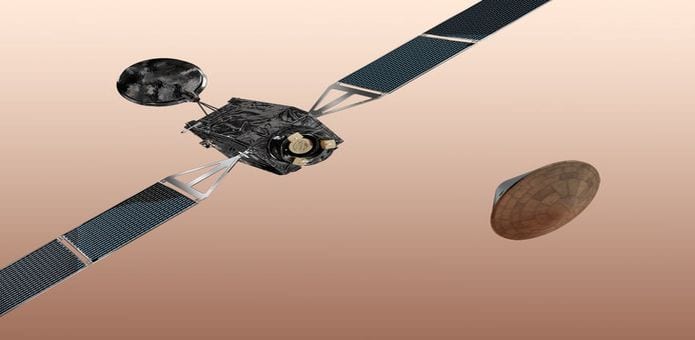Bad code may have doomed ESA Mars lander Schiaparelli
Schiaparelli, which is a part of European Space Agency’s (ESA) ExoMars mission, conducted jointly with the Russian Space Agency Roscosmos that aims to conduct a pre-landing test before the bigger 2020 mission on Mars. However, the probe crashed while attempting to make its first Martian landing on October 19.
The ExoMars spacecraft consisted of two parts, a Trace Gas Orbiter (TGO) and the Schiaparelli Entry, Descent and Landing demonstrator module. The 2020 mission will drill two metres into the Martian surface and study samples for any indicative signs of past or present life on the red planet. The main objective of the ExoMars mission is to search for evidence of methane — a gas produced by living microbes on Earth, and traces of which have been observed by previous Mars missions — and other trace atmospheric gases that could be signatures of active biological or geological processes. It will also be a communications relay for the 2020 rover.
“As it is, we have one part that works very well and one part that didn’t work as we expected,” says Vago. “The silver lining is that we think we have in hand the necessary information to fix the problem.”
Engineers from the ESA have been trying to determine why the lander Schiaparelli crashed into the surface of Mars on October 19th.
“Figuring out Schiaparelli’s faults and rectifying them is a priority. That’s super important. I think it’s on everybody’s mind,” Jorge Vago, ExoMars project scientist said in a statement.
Last week, during Schiaparelli’s six-minute landing manoeuvre, controllers from the bases on Earth lost contact with the lander. Even though the probe was descending pretty well from the time it detached from the mothership to its three-day descent until the moment the lander was expected to fire up its thrusters to slow down its descent.
Evidence from data received from Schiaparelli before the signal was abruptly cut off points to a computer glitch being the most likely cause of the failure.
Preliminary analysis suggests that the lander began the manoeuvre flawlessly, braking against the planet’s atmosphere and deploying its parachute. However, something went wrong at 4 minutes and 41 seconds into an almost 6-minute fall. The lander’s heat shield and parachute ejected ahead of time, said Vago. Then thrusters, designed to decelerate the craft for 30 seconds until it was meters off the ground, engaged for only around 3 seconds before they were commanded to switch off, because the lander’s computer thought it was on the ground.
ESA investigators believe that the instruments might have been turned on and that the lander was ready for the Martian weather and magnetic field. However, the problem could have ignited from switching the gears way earlier or in a way higher altitude than it should.
“My guess is that at that point we were still too high. And the most likely scenario is that, from then, we just dropped to the surface,” Vago added in the interview.
The ESA probe is thought to have fallen to the Martian surface from an altitude of two to four kilometres (1.2 to 2.5 miles). According to the satellite images, the probe was likely travelling at more than 300 km/hr (186 mph) when it crashed into an equatorial Martian plain, it has been confirmed. According to images taken by NASA’s Mars Reconnaissance Orbiter, it may have exploded on impact because its fuel tanks were almost full.
It is very important to determine what happened to Schiaparelli, as it is vital to the future of ExoMars, an ambitious two-stage mission to search for signs of life on the Red Planet.
“That’s super important,” Mr Vago added. “I think it’s on everybody’s mind.”
The primary function of Schiaparelli was to test the automated Russian-designed landing system that will transport a much larger six-wheeled vehicle onto the planet in 2021.

